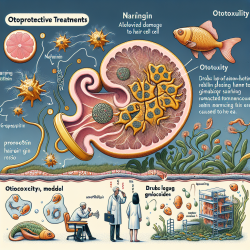Introduction
In the realm of pediatric speech-language pathology, hearing loss is a critical concern, impacting communication development and overall quality of life. A significant contributor to hearing loss in children is the ototoxicity induced by certain medications, such as cisplatin and aminoglycosides. These drugs, while effective in treating cancer and bacterial infections, can lead to the destruction of hair cells in the inner ear, crucial for hearing. Recent research has highlighted the potential of naringin, a flavonoid compound, in mitigating these adverse effects, offering a promising avenue for practitioners focused on improving outcomes for children.
The Research
The study titled Naringin attenuates cisplatin? and aminoglycoside?induced hair cell injury in the zebrafish lateral line via multiple pathways explores the protective effects of naringin against ototoxicity in zebrafish models. The research demonstrates that naringin, when administered in concentrations ranging from 100 to 400 μmol/L, can significantly protect against the harmful effects of cisplatin and aminoglycosides like gentamicin and neomycin.
Mechanisms of Action
Naringin's protective properties are attributed to its ability to engage multiple biological pathways:
- Antioxidation: Naringin reduces oxidative stress, a key factor in drug-induced hair cell damage.
- Anti-apoptosis: The compound helps in regulating apoptotic pathways, preventing programmed cell death.
- Cell Proliferation and Regeneration: It promotes the proliferation of hair cells and supports their regeneration, which is vital for restoring hearing function.
Clinical Implications
For practitioners, the implications of these findings are profound. Incorporating naringin into therapeutic protocols could potentially safeguard against ototoxicity without compromising the therapeutic efficacy of cisplatin and aminoglycosides. This dual benefit underscores the value of naringin as an adjunctive therapy in clinical settings.
Encouraging Further Research
While the study provides compelling evidence of naringin's benefits, further research is essential to translate these findings into clinical practice. Practitioners are encouraged to explore additional studies and consider collaborative research efforts to validate and expand upon these results in human populations.
Conclusion
As we strive to enhance therapeutic outcomes for children, integrating data-driven approaches and innovative solutions is paramount. The potential of naringin as an otoprotective agent represents a significant step forward in safeguarding auditory health against the side effects of essential medications. By staying informed and engaged with ongoing research, practitioners can continue to improve the lives of children affected by hearing loss.
To read the original research paper, please follow this link: Naringin attenuates cisplatin? and aminoglycoside?induced hair cell injury in the zebrafish lateral line via multiple pathways.










